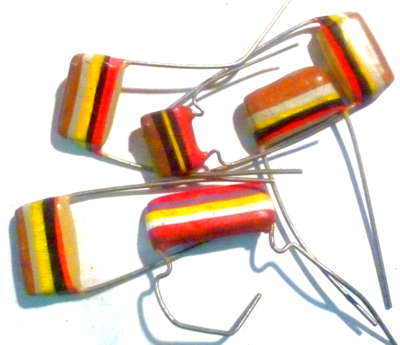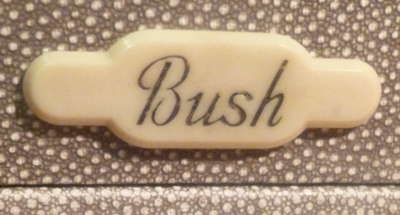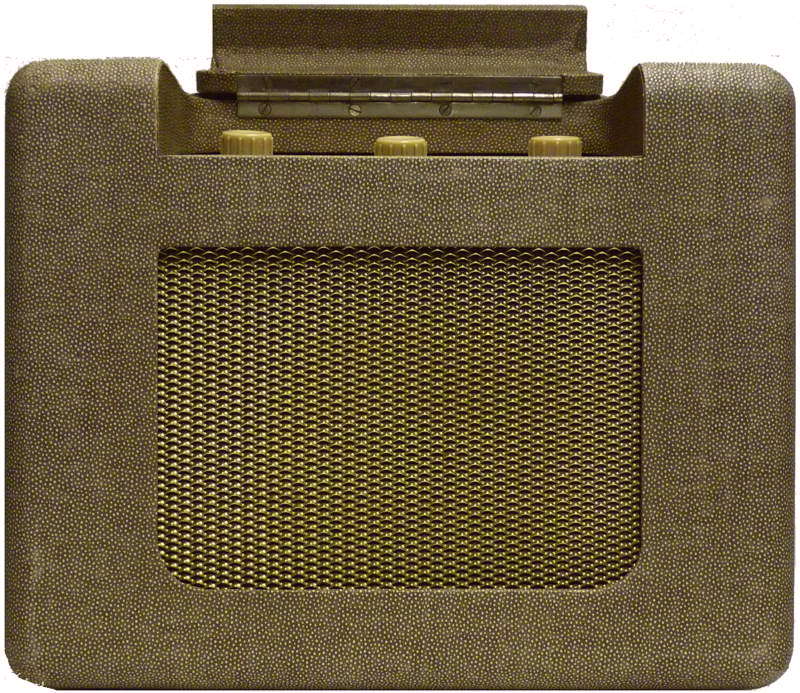
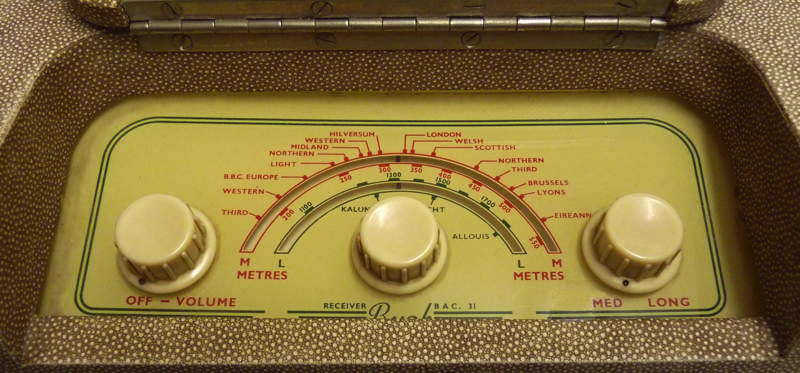
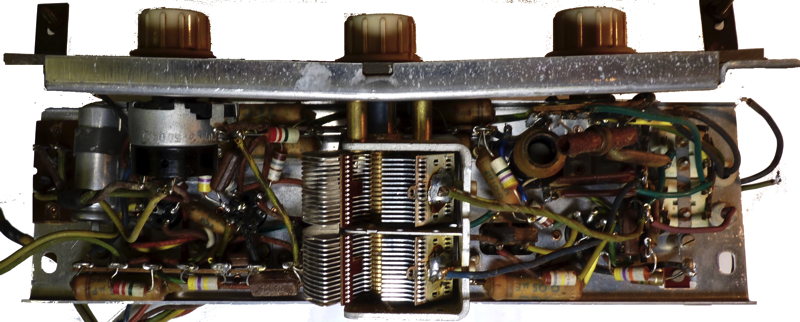
underside
of chassis prior to capacitor replacement
Bush BAC31 s/n "All Dry" battery portable designed to be used with an optional AC only power unit Type 42. This model was introduced in 1953 and is the first post war Bush portable radio designed for battery or mains operation. Long and medium wave working UK 1953/4 Original cost �13 4s 4d plus mains adapter (a �3 accessory)
It is is a four valve, battery operated, portable super heterodyne receiver, incorporating a frame aerial and covering the long and medium broadcast wave ranges. The valves employed are of the Mullard Miniature series,: DK92, DF9l, DAF9l, DL94 feeding a P.M. speaker of 6.5 ins. diameter. Adjustable iron dust cored coils, are used in the oscillator and |.F. circuits. For operation on A.C. mains a Power Unit Type 42 will be required, which is designed to fit into the cabinet of the receiver, thus affording means of operating the receiver from batteries or A.C. mains supply as desired.
Bush used wood for the case of the
model BAC31 which unlike previous models which were housed in painted
Bakelite cases.
The styling of the BAC31 is similar to the post WW2 Roberts the P4D and
P5A, Vidor and the Pye New
Baby Q portable. Common features include hinged rear door and the flap
to cover the controls
when not in use.
VALVES
DK92. l.4V .05 amp.
DF9l |.4V .05 amp.
DAF9l l.4V .05 amp.
DL94 2.8V .05 amp.
BATTERIES
90 volts for H.T. and 7.5 volts for L.T. Recommended batteries being
Ever-Ready Batrymax Type B107 for H.T. and Ever-Ready AD3l for L.T.
supplies.
MAINS OPERATION
The receiver is designed so that it may be operated from batteries and
or A.C. mains supplies. To enable mains operation to be used a Power
Unit Type 42 will be fitted inside the cabinet with space being left
for the batteries at the bottom of the cabinet. The power unit and the
receiver are equipped with four pin plugs and mating sockets so that
the double pole switch on the volume control can be used to interrupt
the mains supply or the battery supplies depending upon the position of
the 'Battery/Mains' switch on the power unit.
REPAIR
AND REFURBISHMENT
This is one of three radios
which belonged to Paul Ogden
who never got round to fixing them and when I received this one it was
not working. The wooden casing had many woodworm holes on both the
inside and outside but otherwise appeared superficially to be in good
condition. After removing the chassis and the frame aerial the the
holes were injected with woodworm killer fluid and those on the outside
filled with fine white decorators filler which worked very well and the
holes are now almost invisible after touching up with water colour
paint and finally clear shoe cream.
The first problem I encountered was that
the socket on the receiver had broken contacts so there was no reliable
connection between the mains unit and the radio. The next was that only
one of the switches on the volume control opened and closed correctly,
this was cured by drilling a small hole into the casing of the
switch assembly and injecting switch cleaner fluid. Several of the
rubber insulated wires were replaced and the faulty plug and socket
wiring to the switch was bypassed to enable the set to be operated
permanently from the mains supply.
With the set energised I was still unable
to get a squeak from it even though the loudspeaker and transformer
proved to be OK. I measured the HT and LT voltages from the power
supply and found them both high which lead me to discover that the
filament of the DAF91 was open circuit! Fortunately I had a spare which
when inserted caused the LT voltage to drop to about 8 Volts and for
some noise from the speaker but the set was still essentially dead. A
finger on the grid of the output valve produced a loud hum which at
least proved the output stage was working.
I decided then to check the capacitors,
the first checked was the large 0.5mFd wax covered capacitor mounted
above the chassis which when disconnected improved things considerably.
An aerial touched on the tuning capacitor brought in faint tunable
signals. I removed the internals and stuffed the casing with a modern
0.47mFd 400V working one. After testing of a couple of others I
decided to change the rest. This was not straight forward due to the
crowded layout below chassis so I had to remove the variable tuning
capacitor and cut them out and replace them one by one with Mullard
C280 capacitors that look like
liquorice all sorts. Now after straightening the front panel and
re-assembly the set now works well and I replaced the Bush logo which
Paul Ogden subsequently found and posted on to me.
